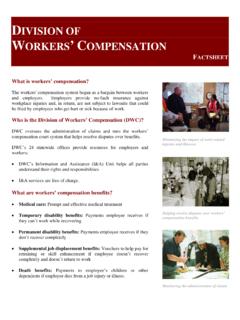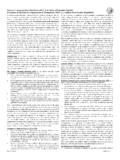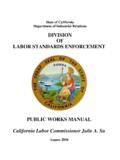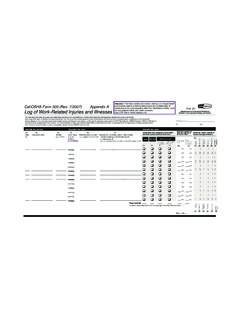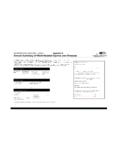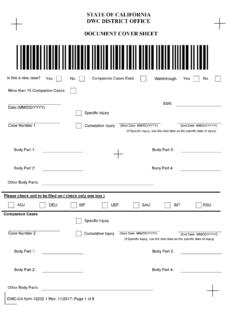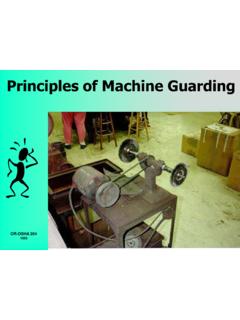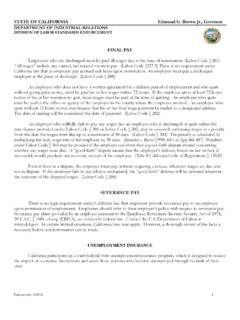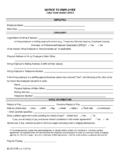Transcription of Chapter 6. Working for Your Employer After Injury
1 26 Workers Compensation in California Chapter 6. Working for Your Employer After InjuryAfter a job Injury , staying at work or returning to work safely and promptly can help in your recovery. It can also help you avoid financial losses from being off work. This Chapter describes how you can continue Working for your I stay at work or return to work, and what work can I do? After you are hurt on the job, many people work with you to decide how you will stay at work or return to work and what work you will do. These people include: Your primary treating physician; Your Employer (supervisors or others in management); The claims administrator; Your attorney, if you have doctors and claims administrators do not fully understand your job or other jobs that could be assigned to you.
2 Therefore, it is important that everyone stay in close touch throughout the process. You (and your attorney, if you have one) should actively communicate with your primary treating physician, your Employer , and the claims administrator about: The work you did before you were injured ; Your medical condition and the kinds of work you can do now; The kinds of work that your Employer could make available to happens while I am recovering?Soon After your Injury , the primary treating physician examines you and sends a report to the claims administrator about your medical condition. If the doctor says you are able to work, he or she should describe: Clear and specific limits, if any, on your job tasks while recovering.
3 These are called work restrictions. They should be based on full and accurate information from you and your Employer about the activities and demands of your job. They are intended to protect you from further Injury . Example: No lifting over 50 pounds at any time. No lifting over 30 pounds more than 10 times per hour. No lifting over 30 pounds more than 15 minutes per hour. Changes needed, if any, in your schedule, assignments, equipment, or other Working conditions while recovering. Example: Provide headset to avoid awkward positions of the head and the doctor reports that you cannot work at all while recovering, you cannot be required to review the steps you can take if you disagree with a medical report, see Chapter 4, pp.
4 15-17 and tips on how to keep your claim on track, see p. 9. See also Chapter 10. A guidebook for injured Workers 27 Chapter 6. Working for Your Employer After InjuryIf You Can Work with RestrictionsIf your primary treating physician reports that you can stay at work or return to work with work restrictions, any work that your Employer assigns must meet these restrictions. Your Employer may, for example, change certain tasks, reduce your time on certain tasks, or provide helpful equipment. Or, your Employer may say that work like this is not available if this happens, you cannot be required to You Can Work Without RestrictionsIf your primary treating physician reports that you can stay at work or return to your job without restrictions, your Employer usually must give you the same job and pay that you had before you were injured .
5 The Employer can require you to take the job. This could happen soon After the Injury , or it could happen much later, After your condition has Employer assigned work that seems to violate my work restrictions. What can I do?You should show the doctor s work restrictions to your Employer and discuss how the restrictions can be met. You don t have to accept an assignment that does not meet the restrictions. If you refuse this kind of assignment, you should clearly explain to your Employer how it fails to meet the restrictions. If possible, do this in your Employer takes or threatens action against you because you won t accept this work assignment, this could be a violation of California Labor Code section 132a, which prohibits discrimination against injured your Employer cannot give you work that meets the work restrictions, the claims administrator must pay temporary total disability benefits (see Chapter 5).
6 If you have questions or need help, use the resources in Chapter 10. Don t delay, because there are deadlines for taking action to protect your happens if I don t fully recover?Your primary treating physician may determine that you will never be able to return to the same job or Working conditions that you had before you were injured . The doctor should report this in writing. The report should include permanent work restrictions to protect you from further assist your primary treating physician, you and your Employer or the claims administrator may jointly fill out a Description of Employee s Job Duties on DWC AD form The doctor can then review what you wrote on the form to make an appropriate review the steps you can take if you disagree with a medical report, see Chapter 4, pp.
7 15-17 and BenefitsIf you lose wages while recovering, you may be eligible for temporary disability (TD) payments. To learn about these payments, see Chapter Workers Compensation in California Can I return to work for my Employer even if I don t fully recover?It depends on whether your Employer can offer you a suitable job. If not, you may be eligible for other benefits if you were injured in 2004 or DATES OF Injury IN 2013 OR LATERIf Your Employer Offers You WorkIf you were injured in 2013 or later and your Employer can offer you work, the claims administrator must send you a Notice of Offer of Regular, Modified, or Alternative Work on DWC-AD form The claims administrator must send this to you within 60 days After the claims administrator learns you have a permanent partial disability that has become permanent and stationary, or P&S (see Chapter 7).
8 Your primary treating physician or another physician who makes this determination must complete and send the claims administrator a report of your P&S status and work capacity on DWC-AD form offer must be for a job that you are able to perform. In addition, the job must: Meet the work restrictions in the doctor s report Last at least 12 months Be within a reasonable commuting distance of where you lived at the time of offer could involve one of the following: Regular work. This is your usual job or position at the time of Injury . It must pay the same wages and benefits that you were paid at the time of Injury . Modified work. This is your old job with changes that meet the doctor s work restrictions.
9 It must pay at least 85 percent of the wages and benefits that you were paid at the time of Injury . Examples: Changing certain tasks, reducing time on certain tasks, changing the workstation, providing helpful equipment, changing the work location. Alternative work. This is work that is different from your old job and meets the doctor s work restrictions. It must pay at least 85 percent of the wages and benefits that you were paid at the time of your Employer offers you work that meets all of the requirements described above: You have only 30 days to accept the offer. If you don t respond within 30 days, your Employer could withdraw the offer. The claims administrator won t be required to offer you a supplemental job displacement benefit.
10 This is true whether or not you accept the Your Employer Doesn t Offer You WorkIf you were injured in 2013 or later, your Employer does not offer you modified or alternative work, and your Injury causes permanent partial disability, the claims administrator must send you a supplemental job displacement benefit, or voucher. Permanent disability is discussed in Chapter 7. Supplemental job displacement benefits are described in Chapter BenefitsIf your primary treating physician reports that you will never recover completely, you may be eligible for permanent disability (PD) payments. To learn about these payments, see Chapter 6. Working for Your Employer After InjuryA guidebook for injured Workers 29 FOR DATES OF Injury IN 2004 THROUGH 2012If Your Employer Offers You WorkIf you were injured sometime in 2004 through 2012 and your Employer can offer you work, the claims administrator must send you a Notice of Offer of Modified or Alternative Work on DWC-AD form The claims administrator must send this to you within 30 days After your final TD offer must be for a job that you are able to perform.
